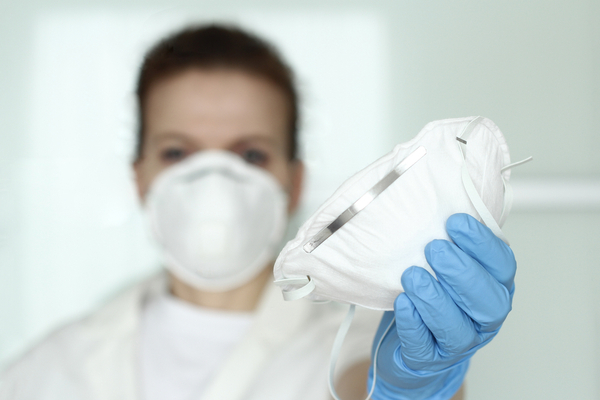NPR reports that with the especially virulent Omicron COVID-19 variant racing across the U.S., once again health authorities are urging people to mask up indoors. Yes, you’ve heard it all before. But given how contagious omicron is, experts say, it’s seriously time to upgrade to an N95 or similar high-filtration respirator when you’re in public indoor spaces.
“Cloth masks are not going to cut it with omicron,” says Linsey Marr, a researcher at Virginia Tech who studies how viruses transmit in the air. Omicron is so much more transmissible than coronavirus variants that have come before it. It spreads at least three times faster than delta. One person is infecting at least three others at a time on average, based on data from other countries.
“It’s very contagious,” says Dr. Robert Wachter, chair of the Department of Medicine at the University of California, San Francisco. “And the kind of encounter that you could have had with prior versions of the virus that would have left you uninfected, there’s now a good chance you will get infected from it.”
True, a cloth mask can be a “marginally OK to maybe a decent filter,” Marr says. But with something as highly transmissible as omicron, just “OK” isn’t good enough. Marr notes that preliminary data from scientists at the University of Hong Kong has shown that omicron multiplies 70 times faster inside human respiratory tract tissue than the delta variant does. That study also found that omicron reaches higher levels in respiratory tract tissue 48 hours after infection, compared with delta.
“That would suggest to me that maybe it reaches higher levels and then we spew out more [virus particles] if we’re infected,” Marr says. And while it’s too soon to tell, she says it’s conceivable that omicron is so good at infecting us, we just need to breathe in fewer viral particles of omicron to get infected. And virus particles from an infectious person can linger in the air indoors for minutes or even hours after they leave a room in some situations, says Dr. Abraar Karan, an infectious disease physician at Stanford University. “I think that people need to realize that transmission here can happen even when you’re not near somebody,” he says.
Given all this, you want a mask that means business when it comes to blocking viral particles. Unlike cloth masks, N95, KN95 and KF94 respirators are all made out of material with an electrostatic charge, which “actually pulls these particles in as they’re floating around and prevents you from inhaling those particles,” Karan notes. “And that really is key” — because if you don’t inhale virus particles, they can’t multiply in your respiratory tract.
The material in surgical masks also has an electrostatic charge. But surgical masks tend to fit loosely, and a snug fit — with no gaps around nose, cheeks or chin — “really makes a big difference,” says Marr, who has studied mask efficacy.
KN95s tend to be a bit more comfortable than N95s, but counterfeits continue to be a problem. For safer shopping, check out a site like Project N95, a nonprofit that helps consumers find legitimate personal protective equipment. Or check the CDC’s site for advice on how to spot a counterfeit and a list of trusted sources for surgical N95s. For maximum protection, make sure your N95 fits snugly as well, creating a seal around your mouth and nose. The CDC explains what makes a good fit and how to test that yours is sealing well.
Still, surgical masks are cheaper than respirators. And if cost is a factor for you, at a minimum consider topping a surgical mask with a cloth mask to ensure a tighter fit, or get a mask fitter — a frame that fits over your surgical mask to make it more snug. While these options won’t offer as much protection as an N95, they’re a big improvement over a cloth mask alone, Karan and Marr say.
As to when to wear a mask, obviously you want to cover up when you’re using public transit, including airports and airplanes, and when you’re indoors in grocery stores or other public places, as with previous surges. Check npr.org to see whether where you live has a lot of cases — most places do right now.
Wachter says he’s also covering up indoors with small groups of friends and family unless everyone is vaccinated and boosted. If they’re not boosted, he says, “I consider them to be somewhere between vaccinated and unvaccinated, and I act appropriately if I’m going to be around them.” That means he either has everyone mask up, or he has everyone take a rapid test to make sure no one is infectious at that moment. “One or the other.” This is especially important if anyone attending is high-risk.
Marr says that with omicron surging, she’d have kids wear respirators if possible when they’re indoors in public spaces. Parents searching for good respirator options for their children can check out the work of Aaron Collins on Twitter, aka “Mask Nerd,” a mechanical engineer with a background in aerosol science. He’s been testing the filtration efficiencies of hundreds of masks and respirators on the market. You can find his reviews on his YouTube channel. (This spreadsheet on kids’ masks may also be helpful.)
Combined with getting vaccinated and boosted, upgrading to a high-filtration mask will be key to enjoying a safer holiday season without having to hibernate, experts say. “I have a lot of confidence in the vaccines, if you’re boosted, in protecting against severe outcomes,” Marr says, “and I have a lot of confidence in an N95 and similar types of respirators. And I think that with those two things, you can still go about a lot of your normal activities.”
—
Photo Credit: sunfe / Shutterstock.com
